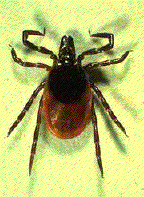|
|
|
 |
 Tick Borne Disease
Tick Borne Disease
(The
following are recommended good work practices and are not OSHA
standards)
Anyone working in the outdoors,
especially in areas with tall grasses, shrubs, low hanging branches, or leaf mold is
susceptible to being bitten by a tick.
- There are several diseases
which can be carried by ticks, with the most well known being Lyme disease.
- The ticks that carry Lyme
disease, as well as several other diseases, are the black-legged tick in the eastern
United States, and the western black-legged tick along the west coast. The lone star tick
is also a possible carrier.
- Other types of ticks carry other diseases, though the diseases
are less common than Lyme disease.
- The ticks can carry disease in
their larval, nymph, or adult stages. In the larval stage they may look like small black
specks, the nymph is about the size of a poppy seed, and the adults can be less than 1/8
inch (3 mm) long.
- There were over 18,000 cases of
Lyme disease reported in the United States during 1997 (total, not just occupational).
Other tick borne diseases affected several hundred people.
- Some estimates indicate that as
few as 10% of the cases of tick borne disease are actually reported.
|
|
|
How do Ticks Get on a Person
- Ticks do not jump, crawl,
or fall onto a person. They are picked up when your clothing or hair brushes a leaf or
other object they are on.
- Ticks are generally found
within three feet of the ground.
- Once picked up, they will
crawl until they find a favorable site to feed. Often they will find a spot at the back of a
knee, near the hairline, or behind the ears.
Precautionary Measures
The best way to prevent tick borne diseases is to avoid tick bites. There are several things
you can do which will lessen your chance of being bitten.
- Wear long pants and a long sleeved shirt. Tuck your shirt into your pants.
Tuck your pants into your socks or boots, or use tape to close the opening where they meet.
- Wear a hat, and tie back long hair
- Use an EPA approved insect repellant or arachnicide (pesticide) which is effective for
ticks, such as DEET (N,N-diethyl-m-toluamide) or pyrethrin. Be sure
to heed all
precautionary information, and be aware that some people are sensitive to these chemicals.
- Wear light colored clothing so that a tick can be seen more easily.
- Change clothes when you return from an area where ticks may be located.
- Shower to wash off any loose ticks.
Tick Check and Removal
- Check clothing for ticks on a frequent basis. If you find a tick, do a more thorough
tick check.
- When you return from an area where ticks may be located, check all of your body for
ticks. It may be helpful to have someone else check your back or other areas which are
difficult to see. Be sure to include:
- Parts that bend (back of knee,
between fingers and toes, underarms).
- Pressure points where clothing
presses against skin (underwear elastic, belts, neck).
- Other common areas (belly
button, around or in ear, hairline, top of head).
- Once inside do a final, thorough tick check and clothing change.
- If you are in a tick infested area or an area known to have disease carrying ticks,
perform the checks on a more regular basis.
- Remove unattached ticks promptly.
- Attached ticks are promptly removed using fine pointed tweezers:
- The mouth parts of the tick are
grasped with the tweezers as close to the skin as possible;
- Apply firm steady pressure
upward until the tick releases - do not jerk, twist, squash or squeeze the tick;
- Clean the wound and the
tweezers with an antiseptic.
- Do not use petroleum jelly or nail polish remover, or prick or burn the tick, these
actions can cause infected secretions to enter the wound.
Other Steps You Can Take
- Place clothing worn in tick infested areas into the dryer for at least 30 minutes in
order to kill any ticks.
- Be sure and check pets and other animals for ticks. Use approved tick repellants or
products which kill ticks.
- If you want to have the tick checked for disease, place the tick in a clean vial or
ziplock bag with a blade of grass, then contact your State Health Department for more
information.
Diseases Carried by Ticks
Ticks can carry a number of diseases. In the United States these
diseases include:
- Babesiosis
(a malaria like infection)
- Colorado Tick Fever (generally in the western United States including the coast)
- Ehrlichiosis
- Lyme Disease
- Relapsing Fever (most common in the western United States)
- Rocky Mountain Spotted Fever (throughout the United States but most prevalent in the east)
- Tick Paralysis
- Tularemia (rabbit fever)
 Additional Related information: Additional Related information:
- The
Lyme Disease Foundation sponsors the Lyme Disease Hotline (1-800-886-LYME) which provides
information on Lyme disease and other tick borne diseases.
- Your State Health Department has information available about Lyme disease in your area.
- Your State Library may have educational materials available.
|
| |
 Back to
First Aid
Back to
First Aid
|
|

